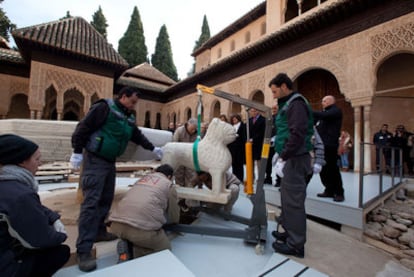Lions roar once more at the Alhambra
Restored statues finally return to guard patio fountain in the Andalusian palace
The expectation was palpable. Journalists and curious bystanders thronged outside of the crypt of the Palace of Carlos V on Monday, to witness the return of lion number eight - one of the most famous sights in the Alhambra Moorish palace and fortress complex, in the Andalusian city of Granada.
After four years of meticulous retouching, under the supervision of María del Mar Villafranca, director of the Board of the Alhambra and the Generalife, the sculpture, weighing 300 kilos, was lowered back into place by crane.
Villafranca, who has overseen the entire restoration project for the patio, was visibly satisfied with the job. Forty minutes before the director's arrival, the lion sat alone, as the few tourists present braved the cold and took photographs amid the commotion. The 11 remaining lions were still in the crypt, wrapped up and waiting to take their place at the fountain later this week.
"We plan to add two or three a day so by the end of the week the fountain will be complete," the director explained. "Thick layers of lime have been removed, which will help protect against the invasion of biological elements, as well as strengthening several cracks. They have also removed harmful metallic elements, and other adhesives, such as cement."
The event also served as a platform to announce the important discoveries made during the restoration process. Although the lions appear to be identical, they bear distinct characteristics. Each block of marble had been carefully selected from a quarry by its sculptor, so the natural grain of the stone stands out in every figure. The lions appear to have different textures of fur, while their jaws hold uniquely grooved teeth.
The restoration project was not limited to just the lions. Thanks to a major investigation begun in 2002, the entire patio has undergone significant changes. The patio will open to the public next spring, with a new, white marble floor that will allow visitors to approach the fountain, which has been inaccessible to tourists since the 1990s.
The archeological investigation revealed that the patio did not originally have a garden, as was previously thought. Francisco Lamolda, the board's conservation architect, explained that it was only during the French occupation that the patio was planted with roses, jasmine and Myrtle trees. "There is not a sufficient depth of earth here for there to have been a garden," he said.
Research reveals that the floor of the patio was originally marble, so the restoration work will return the patio to its initial look. During the next few months, the hydraulic circuit will be completed, so that the lions will once again act as spouts for the fountain system.

Tu suscripción se está usando en otro dispositivo
¿Quieres añadir otro usuario a tu suscripción?
Si continúas leyendo en este dispositivo, no se podrá leer en el otro.
FlechaTu suscripción se está usando en otro dispositivo y solo puedes acceder a EL PAÍS desde un dispositivo a la vez.
Si quieres compartir tu cuenta, cambia tu suscripción a la modalidad Premium, así podrás añadir otro usuario. Cada uno accederá con su propia cuenta de email, lo que os permitirá personalizar vuestra experiencia en EL PAÍS.
¿Tienes una suscripción de empresa? Accede aquí para contratar más cuentas.
En el caso de no saber quién está usando tu cuenta, te recomendamos cambiar tu contraseña aquí.
Si decides continuar compartiendo tu cuenta, este mensaje se mostrará en tu dispositivo y en el de la otra persona que está usando tu cuenta de forma indefinida, afectando a tu experiencia de lectura. Puedes consultar aquí los términos y condiciones de la suscripción digital.








































